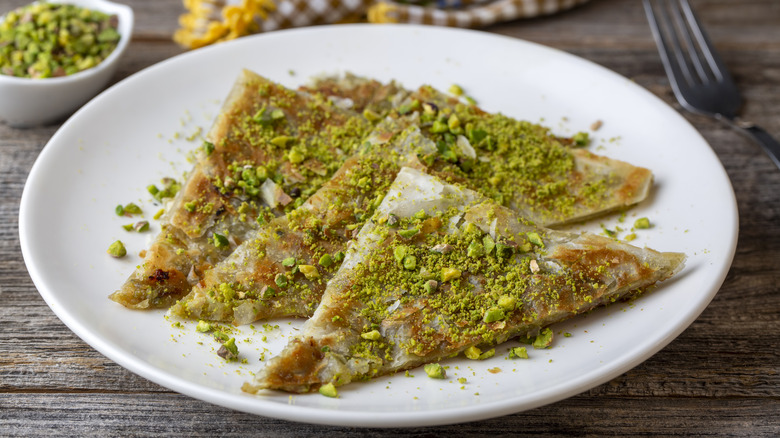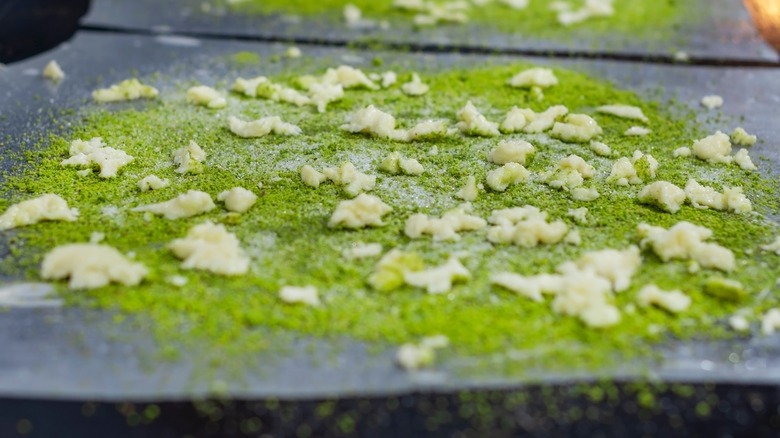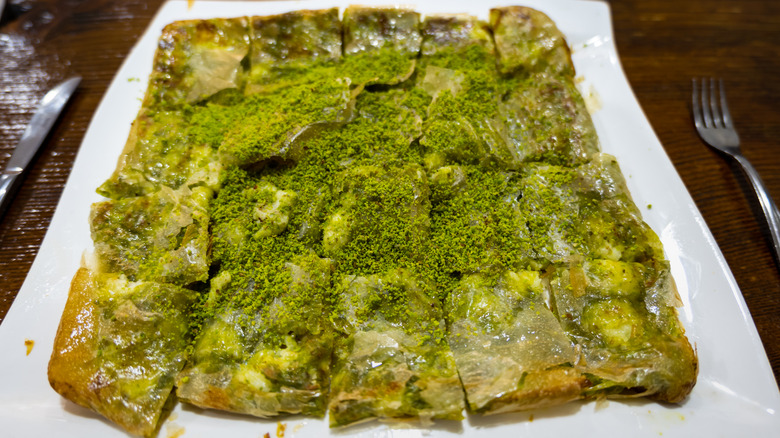What Is Katmer And How Is It Different From Baklava?
Chances are you're familiar with baklava — that irresistibly crispy, crunchy, sticky Middle-Eastern pastry that's made of layered phyllo dough, crushed nuts, and honey. And if you're familiar with baklava, you know just how delicious and comforting this dessert can be. And you probably want to eat some right now.
But what you may not be familiar with is baklava's Turkish cousin, which is just as yummy and comforting, yet doesn't get quite as much attention. Meet katmer: a flat and flaky pastry that dates back to ancient Anatolia (aka, modern-day Turkey). It's made with an impossibly thin dough, filled with all kinds of goodies, and typically served for breakfast.
The decadent treat looks similar to baklava, and you'll usually find these two pastries sold together at the same shops. But there are some minor, yet key, differences between katmer and baklava: namely their filling and their form. Where baklava is stacked, katmer is folded, and while baklava is typically filled with some combination of crushed nuts and sugar, katmer is traditionally made with a whole slew of sweet and savory filling variations.
Katmer vs. baklava: it's all in the filling
The filling is really what sets these two flaky creations apart. Baklava is traditionally filled with slight variations of the same ingredients: crushed nuts — usually pistachios, walnuts, or sometimes hazelnuts — and either honey or a sugary syrup. Sometimes additional flavors or spices like lemon, rose water, cinnamon, and cardamom are included as well, but whatever the ingredient combination, baklava will be a sweet and sticky dessert.
However, it's common for katmer to be either sweet or savory. The most traditional filling is a pairing of pistachios, sugar, and kaymak — a rich, fatty, slightly sour Turkish clotted cream that's made with water buffalo milk. This style of katmer originates from Gaziantep, a town in southeast Turkey that's known for both its baklava and katmer.
But there are several other regional variations that you'll find throughout the country. In Konya, which is more central, katmer is filled with tahini (sesame paste) and topped with either icing sugar or a fruity molasses-like syrup called pekmez, creating a savory-meets-sweet version of the pastry. And nearby in Afyon, you'll find a more decidedly savory variation filled with poppyseed paste.
Katmer vs. baklava: shaping and serving
Both pastry doughs are prepared similarly: First, the dough is made with a base of flour, water, and salt, and eventually, it's rolled out into paper-thin sheets and layered with oil, butter, or both. Some baklava recipes include the addition of starch sprinkled in between the pastry sheets, and most katmer recipes tend to use more oil in the dough-making process — but the end result of the pastry is very similar.
The main difference between the two desserts lies in how the flaky pastry is shaped and formed before it's cut. To make baklava, the phyllo sheets are layered, usually around 10 to 12 sheets at a time. Then the filling is spread on top, and the sheets are layered again; the process is repeated to create a stacked pastry that ultimately gets cut into squares or triangles. Katmer, on the other hand, is folded in on itself multiple times, producing more of an envelope-like square that gets cut into pieces after being baked.
Baklava is typically enjoyed as a decadent dessert that's often eaten at room temperature — while katmer is traditionally served warm and eaten as a breakfast pastry. No matter the time of day, if you're enjoying a piece of either katmer or baklava, it's bound to be a good one.



